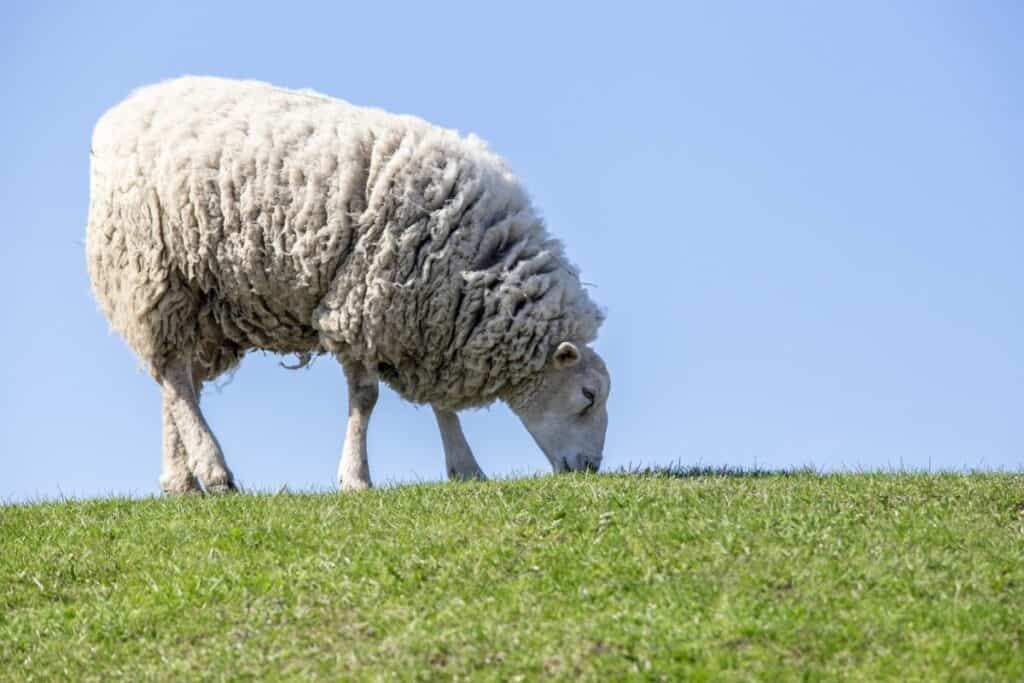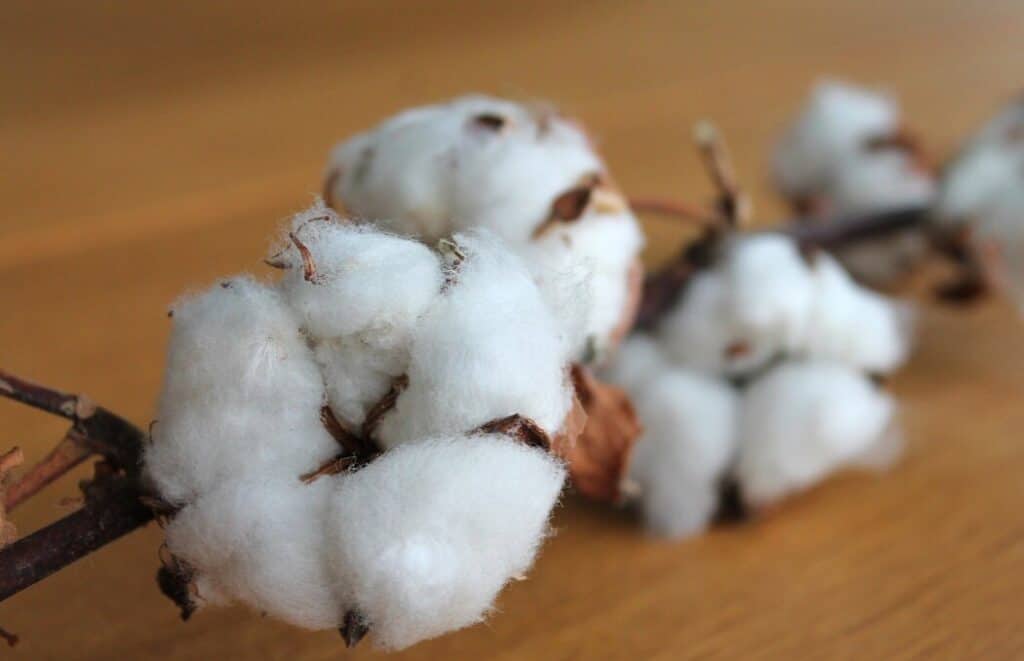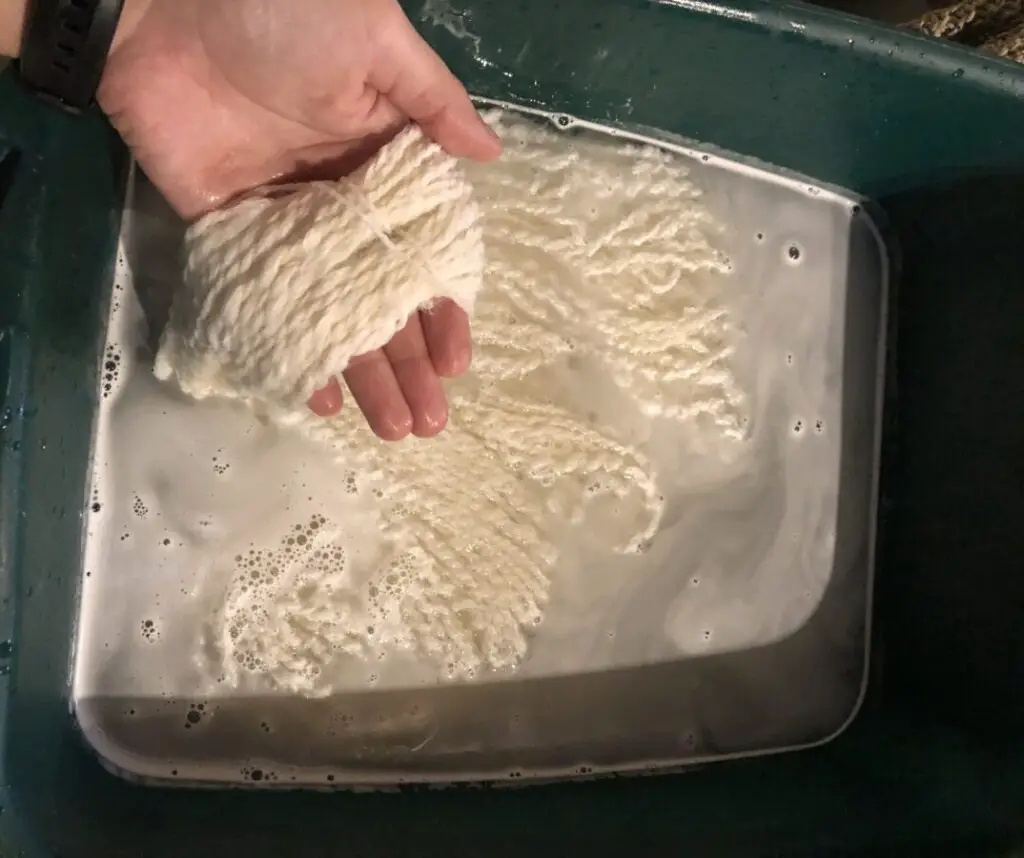If you’re a creator of yarn, or you’re looking to use yarn in your next project, you might wonder if yarn can get wet.
Yes, yarn can get wet. Just getting wet won’t damage the yarn, but, you don’t want it to stay wet. There are many reasons you might want to get yarn wet such as washing and blocking, just make sure you dry it in a reasonable time and dry it according to the material the yarn is made of.
In this article, we’ll dive into the three main types of yarn and discuss how each fiber is affected by water and how to safely dry each one. Let’s jump right in!
Table of Contents
Can Yarn Get Wet?
Usually, yes yarn can get wet without issue. However, different types of yarn react differently to water. The issues normally come during the washing and drying process.
Let’s start with yarn made from wool and other animal fibers.
Wool and Animal Fibers

Animal fibers, also called protein fibers, are fibers that come from animals. These fibers are:
- Wool
- Alpaca
- Cashmere
- Mohair
- Angora
There are some other animal fiber types that I didn’t list but they are rare in the yarn world. For this post, I’ll focus on how wool reacts to water, but all of these things also apply to the other animal fibers listed.
Wool yarn is what most people think of when they think of cozy knit sweaters. Wool comes from various breeds of adorable little sheep. This type of yarn is extremely versatile, ranging from soft and lofty to scratchy and stiff.
It’s also sweat-wicking and keeps you warm even if it does get wet. If you want to learn more about the cool properties wool has when it’s wet, check this out.
However, wool fibers can also be fragile. This fragility is due to something called felting. Felting is what happens when you accidentally throw that sweater in the dryer and it comes out four sizes too small. In other words, it shrinks.
Felting happens when the wool gets agitated and heated while it’s wet. As you can imagine, that means you should be careful getting wool yarns wet. Felting can also happen with all animal fibers.
All is not lost! There are a couple of different ways to prevent your wool from felting. One is to use superwash wool, and the other is to make sure you’re washing your wool correctly.
Nowadays, most of the wool yarn sold in big-name yarn stores is made out of something called superwash merino wool. This wool has been treated with a chemical that can prevent wool from felting in the washing machine.
It’s a good alternative if you’re worried about felting your project but it’s not a perfect solution. Over time and over washes, this chemical treatment can wear off the wool which means it may felt or partially felt during the life of your project. Superwash wool also tends to stretch when it gets wet.
Because of the stretch factor, you should always wash your superwash wool objects in a garment bag and follow the care instructions on the label. Washing hand-made objects in cold water is always recommended.
The last thing to keep in mind is that wool and animal fiber yarns can get moldy. This means that if you get wool yarn wet you need to let it dry or else it could grow some mold.
The best way to get wool yarn to dry quickly is to get a bath towel and roll your skein of yarn up in the towel, pressing down to get the towel to absorb the water. Then just hang the skein up to dry, doorknobs and clothes hangers work great for this!
Now let’s move on to our next type of yarn.
Acrylic and Synthetic Fibers
Acrylic is a synthetic fiber, meaning it’s made in a factory instead of grown naturally, which is becoming more and more common. Acrylic is a cheap wool alternative. It can be similar in softness to wool but without the fear of felting.
However, acrylic yarn doesn’t insulate well when it’s wet and when it’s wet it can feel squeaky. You know, that feeling that you get when you rub things together and they just feel wrong? That’s the feeling you get from acrylic when it’s wet.
There are also times when you might want your acrylic yarn to get wet, like when you’re trying to block acrylic.
Acrylic also doesn’t felt and is completely machine washable which makes it a good alternative if you don’t want to have to hand wash what you’re making.
All that being said, acrylic can be considerably cheaper at the store and can be a good alternative to wool in some projects.
There are other synthetic fibers used in making yarn, some other synthetic fibers are:
- Nylon
- Polyester
- Viscose
- Spandex
- Rayon
These other synthetic fibers vary from acrylic but their properties are similar. You won’t usually find a yarn that is made up entirely of these other synthetics but they are used frequently in blends of fibers.
Cotton and Plant Fibers

Cotton is the most commonly used plant fiber, but there are other natural fibers used in yarns. The most common plant fibers are:
- Cotton
- Flax
- Hemp
- Bamboo
Cotton and yarns are known for their softness but also durability. It is a yarn used frequently for kitchen towels but is also used for summer garments because of its breathability.
Cotton and other plant fibers don’t run the risk of felting when wet like wool can, but they can be very heavy while wet. They’re also not sweat-wicking like wool garments can be.
I think we’ve all had that experience of wearing a 100% cotton shirt in the middle of the summer, it will always show your sweaty spots.
While 100% cotton yarn is quite common, it’s rare to find a yarn that is made up entirely of other plant fibers, they are frequently found blended with wool, cotton, or synthetic fibers.
Cotton and plant fibers are machine washable which means you don’t have to handwash them like you do with wool and animal fiber yarns.
Why Get Yarn Wet?
Now that you know that it’s okay to get yarn wet, let’s talk about why you might actually WANT your yarn to get wet.
The reasons you would wash yarn are as numerous as the things you would do with yarn. Let’s break down each one.
Finishing a Skein of Yarn
If you spin yarn, it’s important to wash the skein of yarn after you’ve finished spinning it. Washing the yarn accomplishes three main things: it cleans any dirt and grime, removes excess dye, and fluffs the yarn.
First, when you spin yarn, you are touching the fibers with your greasy fingers the whole time. This grease helps control the fibers while you spin but you don’t want it to stay on there. So, you wash the yarn once you’re done.
Second, the fiber you used to spin the yarn may have been dyed or you may choose to dye your yarn yourself. If either of those is the case, you’ll want to wash the skein when you’re done to ensure all excess dye is removed.
Lastly, washing a skein of yarn fluffs the fiber together which makes it softer and bonds the yarn together. This process is called fulling.
So, if you’re a hand spinner like me, you’ll wash your fair share of yarn of all types.
Swatching
Knitting, crocheting, or weaving a swatch is an important part of any project. Once you create a swatch, it’s important to wash it.
Washing it will tell you how the yarn will look and react after the project is complete so you can plan your pattern accordingly.
Blocking
Blocking is the process of getting an object wet and then stretching it out into the desired shape and pinning it onto a blocking board. There is wet blocking and there is steam blocking. Both involve wetting the yarn or object either using a spray bottle or a steamer.
This is especially important for projects that have lace because it will open up the lace so it can be fully appreciated.
This could change the finished project’s size and shape but is not always necessary. If you plan to block your project at the end, you should block a swatch to make sure you know how the yarn will react to blocking.
Washing a Finished Garment
Even if you don’t choose to block your project, it’s important to wash any finished piece you create.
In the process of making your object, you will have gotten grease from your fingers on the yarn. I know it sounds kind of gross, but you can’t help it, it’s the price you pay for making something with your own two hands.
Washing a finished object also fluffs the yarn together which can make a difference in what it looks like. This is especially true of wool yarn.
Because of these two things, you should wash your finished garment. Follow the care instructions on the yarn label for the yarn you used.
If you’re worried about how this will change your finished object, make a swatch and wash it to see how it reacts to the washing.
How to Wash Wool Yarn

Now that we’ve talked about each type of yarn, let’s take a moment to talk about how to wash wool yarn safely.
If you want to wash your yarn but you’re afraid of it felting it, you’ll want to wash it carefully to avoid felting. Here’s a quick guide on how to wash your wool yarns without felting them.
First, you’ll want to fill either a sink or a tub with hot water. Don’t fill the tub with the yarn inside, this could cause it to felt.
Once your sink is full of water, add your soap. You can use some wool-specific soap called wool wash or just plain old dawn dish soap.
Now, add your wool yarn to the hot water. If you’re nervous about felting it, you can use cool water instead of hot water just to make extra sure.
When you add your yarn, do not agitate it. Simply drop the yarn right into the water, and then gently press it down to the bottom of the sink.
When you press it down make sure you’re going straight down. Don’t swish it side to side or agitate it in any way! This can cause your wool to felt.
Once your yarn is completely soaked, let it sit in soapy water for 5-10 minutes.
After it’s soaked, take your yarn out of the water and squeeze the excess water out. While you’re doing this do not ring it out. That twisting motion can create friction and felt your wool. I fold the skein of yarn in half and then just work my way down, gently squeezing along the way.
Now that your yarn has been washed, time to rinse. To rinse the wool, just repeat the above steps but without the soap. You may have to rinse it twice to get all the suds out.
Once your yarn has been thoroughly rinsed, you just hang it up to dry. I usually drape it over a clothes drying rack or put it on a clothes hanger.
Taadaa! You’ve successfully washed your first skein of yarn without shrinking it.
If my brief overview doesn’t cut it for you, here’s a great youtube video that’ll show you how it’s done.
Related Questions
What Yarn is Water Resistant?
Wool and some other animal fibers are water-resistant and odor-resistant. For information about how animal fibers compare to wool, check out my posts comparing wool to cashmere, alpaca, and mohair. I also have a post about why wool is odor-resistant.
Does Washing Yarn Soften it?
If yarn is made out of a coarse fiber, then washing it won’t make it softer. However, if the yarn is made out of a soft fiber and the yarn seems stiff, then washing it could help soften it. You should avoid using fabric softener on wool yarns as this can make them pill more.

